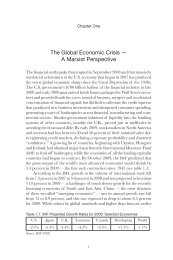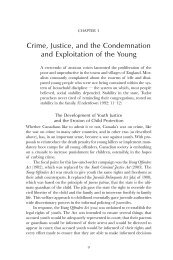Download PDF - Fernwood Publishing
Download PDF - Fernwood Publishing
Download PDF - Fernwood Publishing
You also want an ePaper? Increase the reach of your titles
YUMPU automatically turns print PDFs into web optimized ePapers that Google loves.
The Míkmaw Concordat<br />
9. This story is taken from ancient teachings of our elders. Special thanks to Keptin<br />
Stephen Augustine, Big Cove, N.B., for compiling the ancient story in his<br />
Introductory Guide to MicMac Words and Phrases (1991) and his many conversations<br />
on this topic.<br />
10. Translated as “our souls.”<br />
11. Wji represents personal, jaqa represents reflected or mirror image, and mi represents<br />
alive, animate force.<br />
12. Through the concept of kjijaqamijinaq, Catholic priests united these three parts of<br />
the aboriginal version of the Míkmaw soul in the hieroglyphic prayers concept.<br />
They also transformed mntu into manitu, the symbol for the devil.<br />
13. Translated as “unfolding visions.”<br />
14. Wabanaki (waponahkik) refers to the Algonquin sound describing “the space of the<br />
dawn,” “land of dawn” or “the east.” The Wabanaki Confederacy is addressed as<br />
Waponahkiyik; Penobscot are Panwapskewiyik; Passamaquoddy are<br />
Peskotomuhkatiyik; Malecites are Wolastoqiyik; and Míkmaq were Mihkomak.<br />
Wabanaki was only one of many great confederacies of America.<br />
15. “Ricamanen” was used by the missionary Biard (1856–96:91). It is a misunderstanding.<br />
Father Massé corrected the world to “Nicmanen” (Nietfeld 1981:468, fn.<br />
17). Nikmanen is one person, the proper word is Níkmanaq, which means “the<br />
extended allied people” or, as used by modern Míkmaq, “a reunion of friends and<br />
relatives” (Campeau 1967 (1):489, fn. 7). It is represented in the Míkmaq hieroglyphic<br />
prayers as níkmaq or “my friends” (Schmidt and Marshall 1995:42) and<br />
níkmaninaq or “our friends” (Schmidt and Marshall 1995:105).<br />
16. In the Wapapi Akonutomukonol (Leavitt and Francis 1990), uhkomiks is their name<br />
for “a related group,” kehsuhkomiksit means “many related groups or tribes.”<br />
Sakamo means “a chief,” sakamoak i means “chiefs,” and kcisakomak means “great<br />
chiefs.” Skicinu means “the Indians”; skicin means “an Indian.”<br />
17. The Wabanaki concept for joining one another in a confederacy is tolakutiniya<br />
(literally, “they be related by kinship ‘one other they were’”). The Passamaquoddy,<br />
Malecite and Míkmaw called it the Putusosuwakon or the Convention Council or<br />
kcimawe putuwosuwakon, that is “a great joint council meeting” (kjilatlutwagn in<br />
Míkmaq). To meet in council is Putuwosin; when everybody meets in council it is<br />
Putuwosiniya, and the councilors were addressed as putuwosuwinum. In a council<br />
meeting, the alliance was addressed as kcilakutuwakon or “great kinship or<br />
confederacy.” However, the Penobscot as speakers for the Wabanakis often used<br />
the terms Peskuwok (those united into one) or Kisakutuwok (they are completely<br />
united or already related). The confederacy laws were called tpaskuwakonol or<br />
“standards.” All these laws had to be made in wampum; they would be read<br />
annually or whenever asked what had happened on that occasion (Msiw yuhtol<br />
tpaskuwakonol cuwi lihtasuwol wapapik wecihc kisokitasik tan tehpu eli kinuwi<br />
tpiyak). See Leavitt and Francis 1990:51–61. Among the Míqmaq, this concept was<br />
wtpskwaqanl meaning those hosting the meeting are the holders of the processes<br />
and standards.<br />
18. Translated as “able to teach themselves.”<br />
19. Many versions of this story have been printed. See Rand 1894:225; Ray 1996:38.<br />
20





